Time Capsule – Through the Lens of Jere Alhadeff
Our longtime friend Jere Alhadeff (pronounced Al-Ha-Deff), is one of the greatest drag racing photographers of all time and a true gentleman. We are lucky to present some of his work here in today’s Time Capsule story.
Jere has been photographing cars and motorsports for over 50 years in Southern California. He began shooting drag racing at Lions Drag Strip in Long Beach, California in 1965. His interest in photography dates back to high school where he honed his skills at the school’s newspaper.

After finding his way to the drag races where he shot for a year or so, Jere was offered the track photographer job at Lions. He immediately accepted it. He also began freelancing for several hot rod and drag racing monthly magazines continuing to develop his craft. After the Lions gig, he was offered the same position at Irwindale – a track equally as famous for its cheeseburgers as it was thrilling racing (One of its owners was also the owner of In-N-Out Burger). Jere told them he would become Irwindale’s Track Photographer for the same money Lions was paying if they also included two cheeseburgers!
Fully immersed in the heyday of So-Cal drag racing, he went on to serve as Track Photographer at Orange County International Raceway in the late 60s before returning to Lions to shoot for new track manager, Steve Evans. Besides being one of history’s elite trackside lensmen, he’s the only person to have been track photographer at three of the four Southern California drag strips that were active at that time.
We’re proud to share some of Jere’s greatest photos with his own captions describing the action. His wish is that you enjoy looking at them as much as he enjoyed taking them.

Bob Brooks would later achieve drag racing fame as an innovative racing equipment manufacturer who among other things helped develop the multi-stage clutch that so vastly improved drag race performance. However, this photo from the mid-1960s at Lions Drag Strip shows Brooks, who was a Top Fuel driver at the time, having a starting line “discussion” with Larry Sutton, the Lions Starter. Larry listened politely, but from his stance, I don’t think he changed his call!

Orange County International Raceway at its best. “Wild Willie” Borsch in the Marcellus & Borsch “Winged Express” AA/ Fuel Altered staged and ready to launch. Willie was famous for leaving the starting line with his left hand grasping the side of the cowl while steering with only his right hand. He claimed it kept him from overcorrecting! It is so nice to see the people on top of the tower, and the bleachers full. Great memories!

This was a cover photo for Drag Racing magazine in the early 1970s. This car had an enclosed cockpit, so I was a bit concerned. The car was fired, the gasoline was lit and driver Larry Bowers hit the throttle. The car moved a couple of feet and the engine promptly died. No one had thought to check the fuel level in the tank and the car had run out of fuel! Fortunately, it had enough momentum to clear the fire.
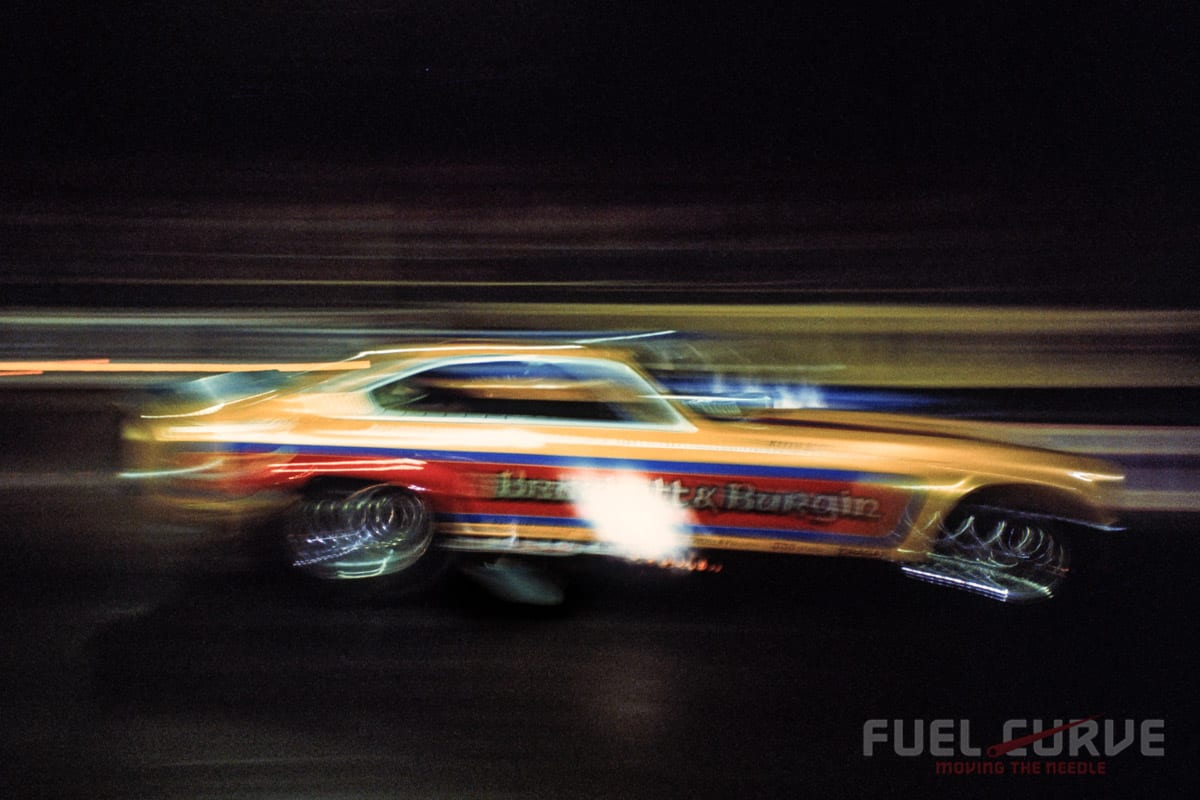
Unlike our present-day photography options, where you can easily dial in any ISO, (or film speed as it was called in the past,) shooting with film was an entirely different story – you were very limited. Lions had the best and brightest starting line light, so before it closed in 1972 I wanted to try some “available light” night action photography. For this photo of the Braskett and Burgin Vega I pushed Kodak 64 speed Ektachrome 3-stops to a film speed of 500. I believe the shutter-speed was a 30th or 60th of a second.

Steve Carbone and John Mulligan were good friends. Here Mulligan, driving the famed Beebe & Mulligan car in the far lane had a slight holeshot, while Carbone in John Bateman’s Atlas Oil Tool Special launched the blower. While all the other photographers ran from the blower boom, I was on a ladder and thought if I jumped I would probably break a leg. I snapped the shutter and caught the big boomer.

Lions Drag Strip had a fairly open photographer’s area just off the starting line on the spectator side that featured a wooden barrier to “protect” the photographers, however, it was open near the starting line for access. This photo of Steve Carbone in the early Atlas Oil Tool dragster was shot with a normal lens from a 4-foot ladder right next to the asphalt. The noise from the new “zoomie headers” really rang my bell!

Steve Carbone (far lane) in the Crietz and Donovan dragster joyously flashes the victory sign while putting a holeshot on Larry Dixon Sr. in the Howard Cams Rattler who smoked the tires. Just after this picture was snapped, the Crietz car broke the rear end! Carbone could only coast down the track while Dixon smoked past him for the victory at the Hot Rod Magazine Championships.

Leslie Lovett was NHRA’s Photo Director, but he was also one of the “guys” who loved drag racing photography. At the Supernationals at Ontario Motor Speedway, he had a 15-foot ladder set up. He asked me if I would like to try it and I quickly accepted. Here, Richard Tharp in the Carroll Bros. dragster does his burnout and for some reason, the left slick is not smoking while the right one is going crazy. Tharp then tries to steer away from the ladder (with me on it)!

This photo was taken at the Goodguys Jim Davis Memorial at Sears Point Raceway in the early 90s. There was a small flag stand platform next to the track where you could look almost straight down the dragstrip to the starting line. On the left is the Champion Speed Shop twin-Chevy dragster driven by Mike McClennan with Art Chrisman’s Hustler to the right. Note the difference in how the zoomie headers affected the tire smoke on the Champion car. That’s former Sears Point Manager Mike Yurick flag starting the pair.

Gary Densham leaves a trail of carnage behind his blown gas roadster. After completing his burnout he tried to get the car into reverse. The engine was running, and he kept winging the throttle but it would not move for obvious reasons. Gary went on to have much better days as a Funny Car racer.
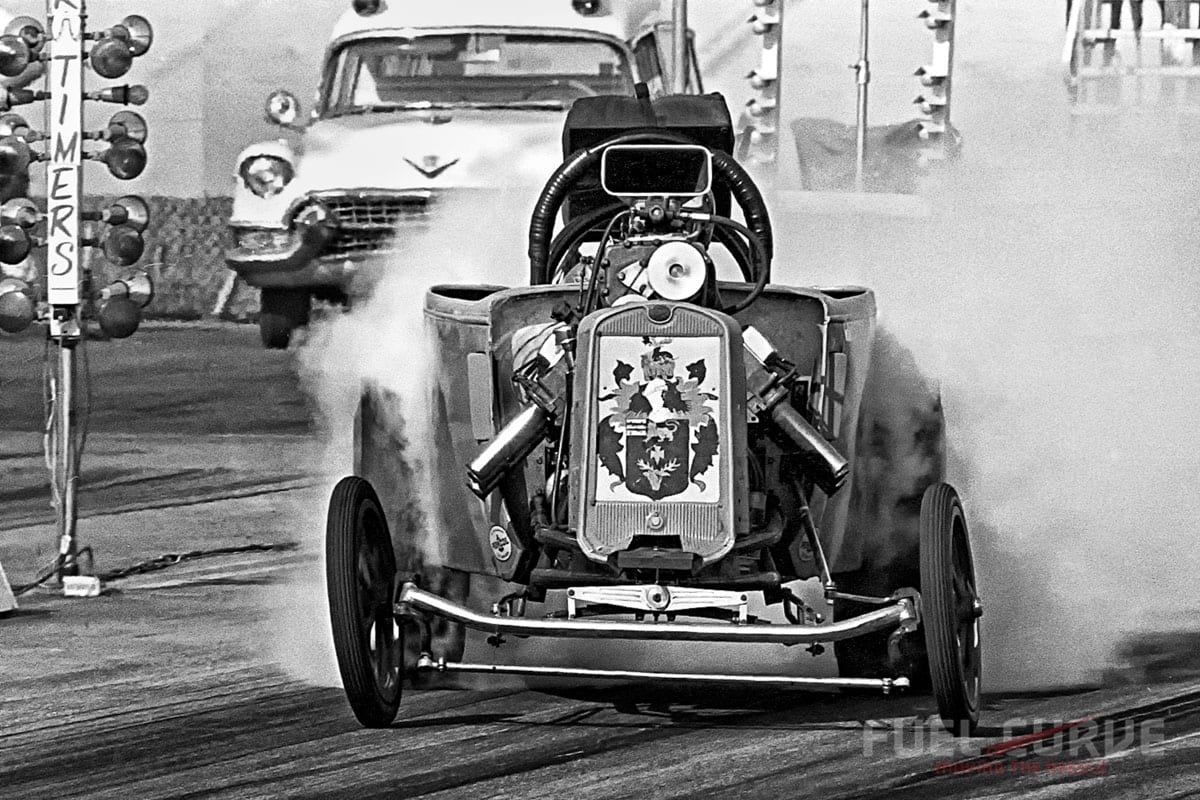
A classic fuel altered photo that has been published many times. The car was owned by Frontuto and Hartwell, and while I do not remember seeing it run much, here you can see it crossed-up leaving the starting line at Irwindale Raceway. I’m not sure what make the roadster body was. Note the cowl vents on both sides—but the engine was a blown Oldsmobile. Adding to that vintage feel is the 1957 Cadillac Ambulance parked behind it.

This photo is from the 1967 NHRA Winternationals in Pomona. While “Funny Cars” had started to become popular, NHRA did not quite know what to do with them. One problem was that the term “Funny Car” was considered too low-brow for a sport trying to increase its professional appearance. Bill Lawton in the Tasca Ford Funny Car, which I think might be a qualifying run, was paired against one-hand Willie Borsch in the Winged Express Fuel Altered.

I believe this may be the only action photograph of Gary Gabelich’s rear-engine, 4-wheel drive funny Vega with a monocoque chassis. On a weekday at OCIR I was working on a feature shoot on a different car. When I saw Gary’s car roll up to the starting line, I ran over and shot this photo just before he got crossed-up and had to lift. Later in the day, they made another attempt without the Vega body and the car went over the guardrail and was destroyed. Gabelich was severely injured.
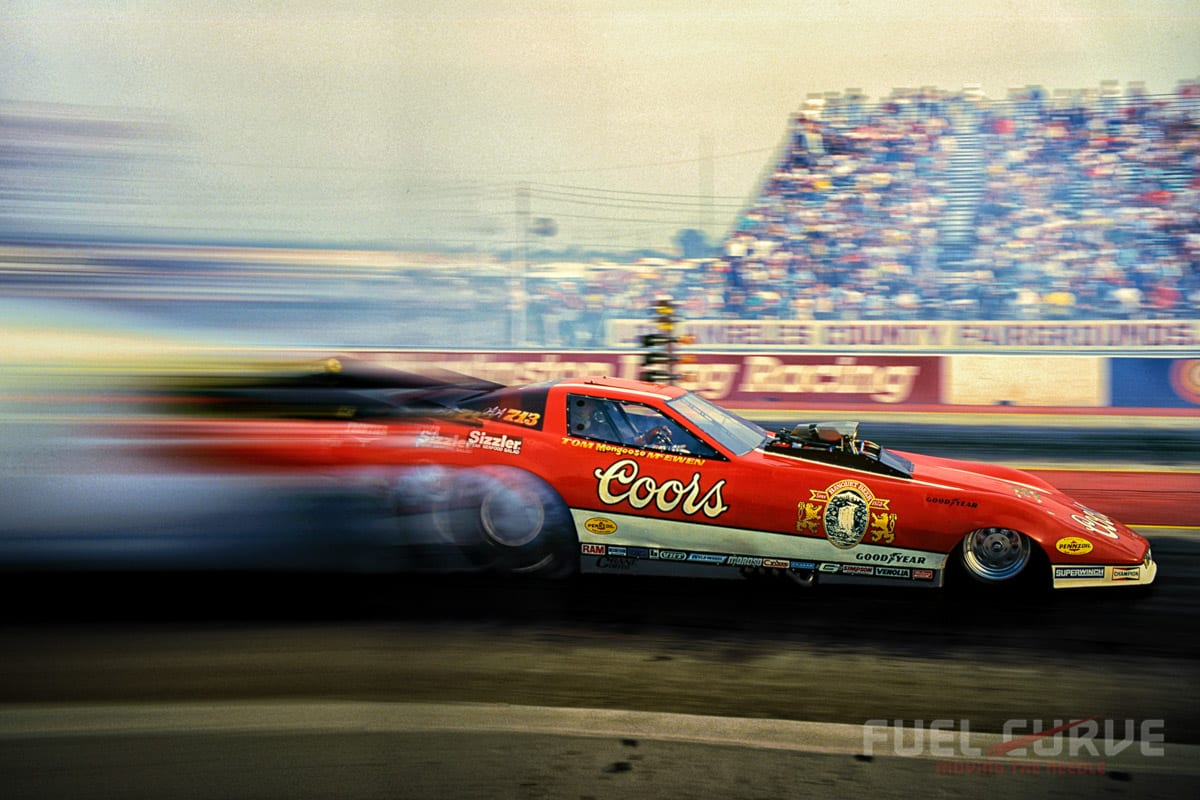
Tom “the Mongoose” McEwen competed for the last time in his Coors Corvette Funny Car at the NHRA World Finals held in Pomona in 1992. I was using a Cokin streak filter that takes part of the subject and blurs it away in a streak, hence the name. While panning a moving object and trying to get just the right amount of blur could be difficult, I was more than happy with the result shown here.

I remember that Steve Reyes, one of the best drag race photographers at the time, came up to me after this photo was featured as a center spread in DRAG RACING magazine and told me he thought it was one of the greatest two-car race photos he had ever seen. He added he felt that way because both cars were doing something wrong at the same time. I was just in the right place at the right time!

This is arguably my favorite of the 1,400-plus drag racing photographs I have taken over the past 50 years. With action photography many times a spectacular event unfolds before your eyes and you are there at the right moment to capture it. In this case, I knew what I wanted the photo to look like and set about figuring out how to accomplish it. One key component was a flat aluminum tripod base I used for this shot that famed metal-master Tom Hanna made to my design. I was honored and proud when this image won First Place at the first Leslie Lovett Memorial Photo Contest at the California Hot Rod Reunion after Les’ death in 1996.
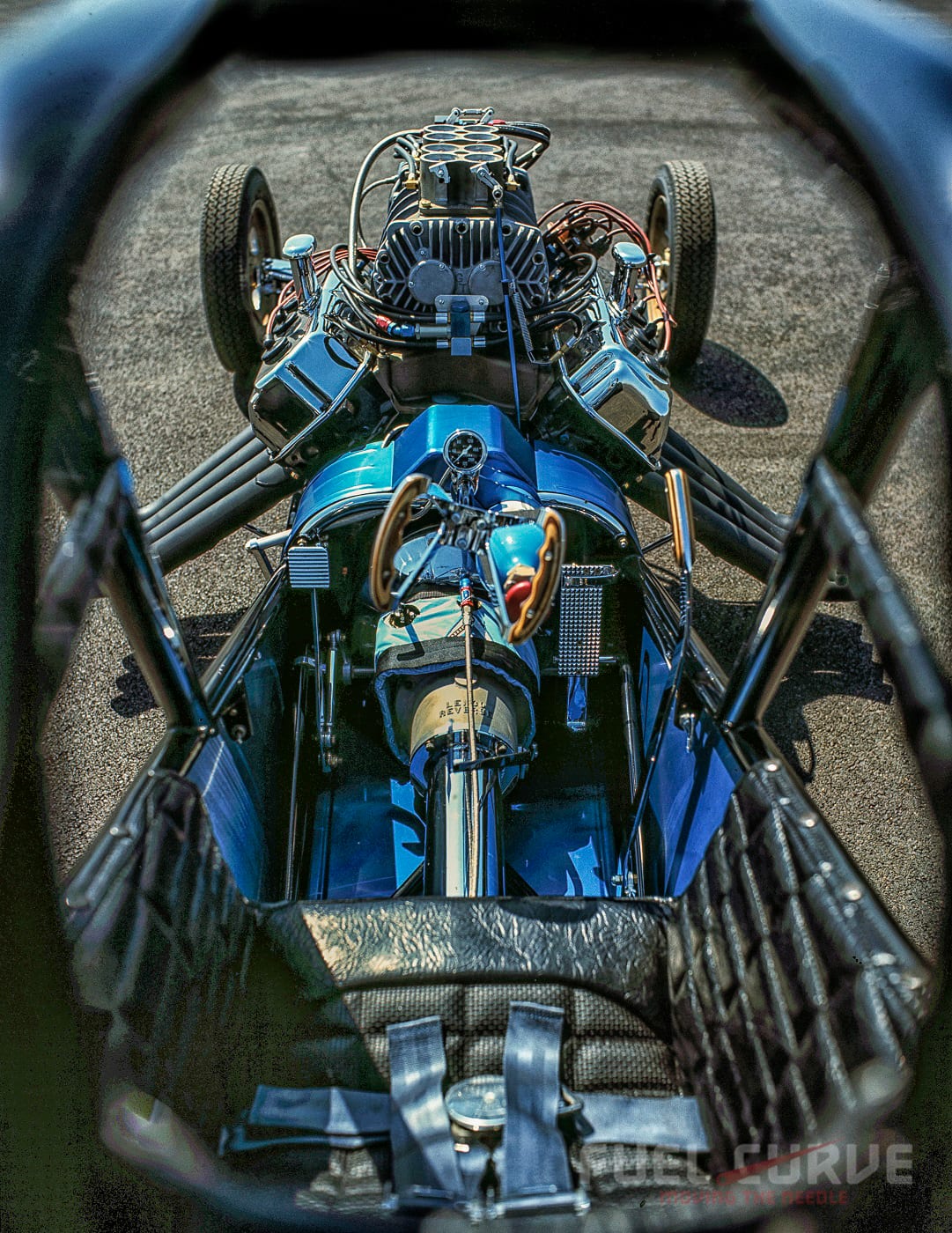
Jerry Ruth called himself “The King of the Northwest.” In truth, he did dominate Northwest nitro racing for many years. Not only did the King’s cars run great, they also were always kept in pristine condition. Here is a driver’s eye view of his Mustang funny car minus the body. I hope I succeeded in showing how well detailed it was.

“Jungle Jim” Liberman always had the reputation of being drag racing’s wild man. He loved to go fast and to put on a show. He was a true uninhibited spirit. Shown here tuning up the engine in his funny car he does sort of exhibit the look of someone from the jungle! He was known to race his car four or five times a week if possible. He died in a traffic accident September 9th, 1977.

I would like to say that my intention when I took this photograph in 1965 was to capture the feel of Lions Drag Strip and 1960s drag racing. But in truth, I was just trying to get a nice shot. Years later, many years after Lions had closed, I came across this photo and realized how well it did capture its element. A thank you to” Billy the Kid” Scott in his father’s “Scottie’s Muffler” dragster. What a beautiful wheels-up launch.

Only having limited funds, I had to pick and choose what cars I would shoot before I ran out of film. When the little-known Magic Muffler altered fired up, my friend Ron Lahr and I both put down our cameras. Then, we jokingly challenged each other. “I can take a better picture of this car than you” we both proclaimed. The rest is history. The car exploded, and we both got photos that have been published and sold many times since.
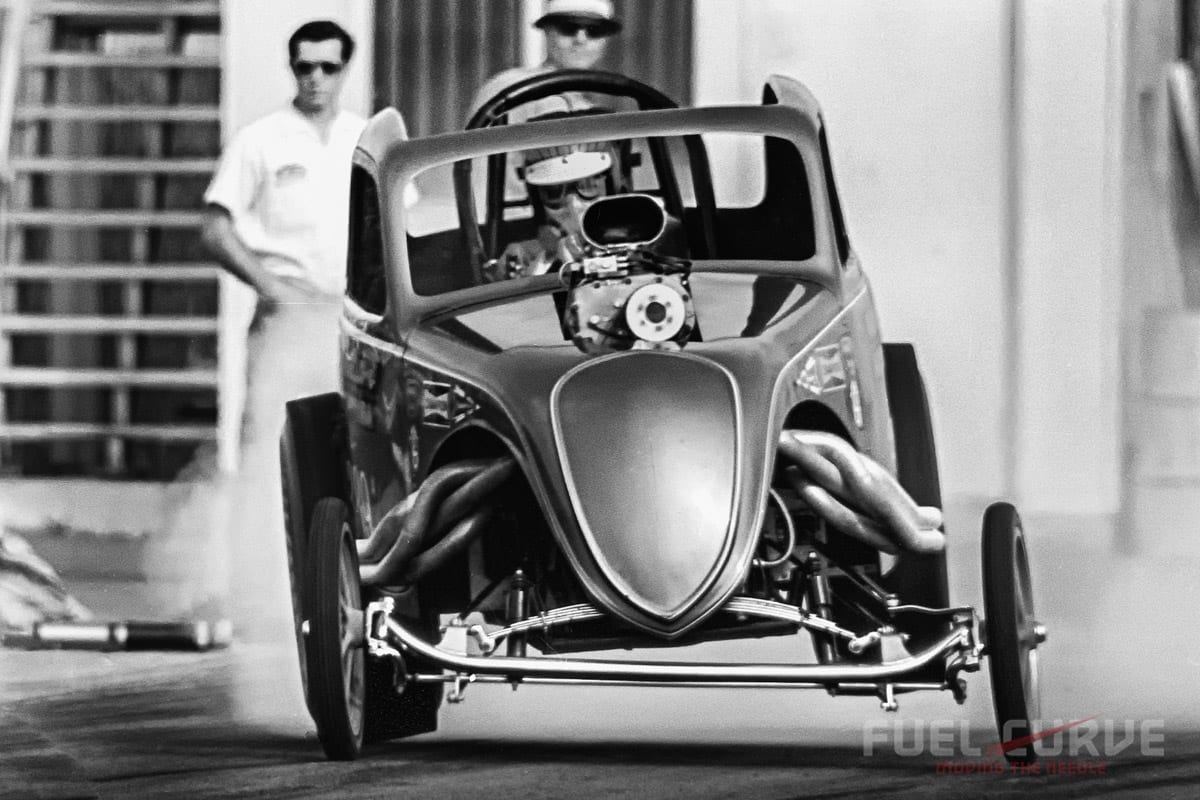
A friend of mine photographed a lot of surfing while we both were attending community college earning our AA degrees in photography. When photographing surfing he used a two-piece 800mm lens that had to be used on a tripod. I borrowed it one Saturday to photograph drag racing at Irwindale. Here Sush Matsubara in the Mondello altered is bouncing after doing a wheelstand. If you look closely, only one tire, the right front, is fully on the ground.

Riverside Raceway was a great road-racing track with a straightaway so long it was used as both a quarter-mile and a half-mile drag strip! It featured a bridge that allowed you to be right over the track just past the quarter-mile finish line. This photo of John Mulligan documented that the slicks were actually growing away from the wheels, which was a problem racers had long suspected.

This is one of my favorite photographs of a drag-bike. This was a run, not a burnout. The rear wheel is turning so much faster than the front wheel and the smoke is just billowing off the slick. It was always a thrill to watch Boris Murray on the Murray and Cook Triumph. They ran at Lions almost every Saturday night.

Every year that the 64-car Manufacturers Championships Funny Car race was held at OCIR they would line up all the cars on the track. The first year, or so it was after Sundown and the cars looked great under the lights, but it took a while to then get the cars back to the staging lanes. Here at the 1969 event, the cars were lined up in the daylight. Still an impressive photo though.

Pete Robinson was an innovator and brilliant racer who always seemed to have a trick or two up his sleeve. This photograph was taken literally seconds before his tragic death. Shown here, just entering the first mile-per-hour light at the 1971 NHRA Winternationals at Pomona, you can see that the air dam Pete had installed under the car is pulling the front end down too hard, stripping away the front tires. Also, his helmet is so far up on his head that it appears that the strap was not secured. It was a dark day in Pomona.

Talk about some tire smoke! No feathering the throttle here! Leon Fitzgerald in the Pure Heaven II Fuel Altered has the butterfly injectors wide open and is just hanging on. The blown big-block Chevy car always gave the Hemi powered cars a good run. Fuel Altereds were always unpredictable, consistently thrilling fans with a great show. Eventually, slipper clutches made the cars quicker but took away the beautiful tire smoke.

Pure Hell! What a great name for a Fuel Altered! Rich Guasco’s Pure Hell from Pleasanton, California was originally built with a small block Chevy for power but after a wild crash at Fremont, the roadster was rebuilt with new front suspension and a Hemi powerplant. This photo was taken at ground level and I love the way you can see the header flames from each individual cylinder before they merge. The reflections on the side of the body are the staging lights. Dale Emery drove the iconic Bantam roadster.

This photograph of Don “The Snake” Prudhomme in his rear-engined Hot Wheels dragster is one of my favorite parachute shots. It was taken at Irwindale with the camera right on the ground, hence the water vapor waves at ground level compressed by the telephoto lens I was using. It was especially nice of The Snake to give me a thumbs up when he saw me at the side of the track. I assumed he had won the round.

This image was shot with a medium-format camera. Medium format cameras provide a square image. The image looked best (to me at least) as a full square. For magazine layout, however, most pictures are cropped in a rectangle shape which would have eliminated the tower. Fortunately, Drag Racing Magazine Art Director Lane Evans agreed with me and used it as a square image in a centerspread with no cropping. It was an added bonus the headers were starting to get red-hot.




